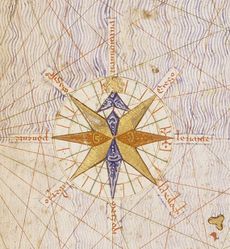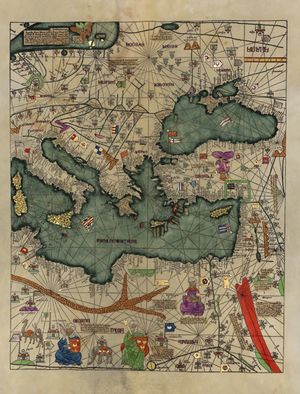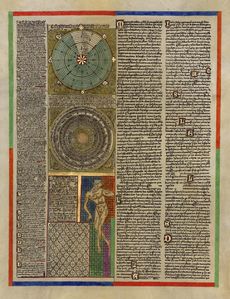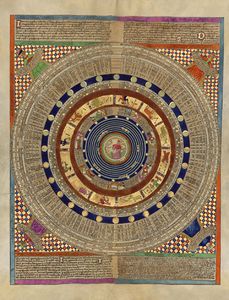الأطلس القطلاني

الأطلس القطلاني (قطلان: Atles català؛ قطلانية شرقية: [ˈalːəs kətəˈla]؛ التهجي القديم: Atlas Catalan) هي خريطة صُنِعت في 1375، والتي وُصِفت بأنها أهم خريطة في القرون الوسطى باللغة القطلانية,[1][2] and as "the zenith of medieval map-work".[2] وقد أنتجتها مدرسة رسم الخرائط المايورقية ونُسِبت إلى Cresques Abraham (المعروف أيضاً بإسم "Abraham Cresques"), a Jewish book illuminator who was described by a contemporary as a master of mappae mundi as well as of compasses.[3] وكانت في المكتبة الملكية الفرنسية (التي هي الآن المكتبة الوطنية الفرنسية) في 1380، في عهد الملك شارل الخامس. The Catalan Atlas originally consisted of six vellum leaves (each circa 64.5 by 50 cm [25.4 by 19.7 in]) folded vertically, painted in various colours including gold and silver.[4] These were later mounted on the front and back of five wooden panels, with the ends enclosed in a leather binding by سيمون ڤوستر c.1515, restored most recently in 1991; due to wear, each leaf has split into two halves.[4]
. . . . . . . . . . . . . . . . . . . . . . . . . . . . . . . . . . . . . . . . . . . . . . . . . . . . . . . . . . . . . . . . . . . . . . . . . . . . . . . . . . . . . . . . . . . . . . . . . . . . . . . . . . . . . . . . . . . . . . . . . . . . . . . . . . . . . . . . . . . . . . . . . . . . . . . . . . . . . . . . . . . . . . . .
الوصف
The first two leaves contain texts in Catalan covering cosmography, الفلك, and astrology. These texts are accompanied by illustrations. The texts and illustration emphasise the Earth's spherical shape and the state of the known world. They also provide information to sailors on tides and how to tell time at night.[5]
The four remaining leaves make up the actual map, with Jerusalem located close to the centre; two depict the Orient and the remaining two Europe and North Africa. The map is around 1.3 m2 (14 sq ft) in size. It shows illustrations of many cities–Christian cities with a cross, other cities with a dome–and with each city's political allegiance indicated by a flag. Wavy blue vertical lines are used to symbolise oceans. Place names of important ports are transcribed in red, while others are indicated in black. The illustrations and most of the text are oriented towards the edges of the map, suggesting it was intended to be used by laying it flat and walking around it.[6]
The oriental portion of the Catalan Atlas illustrates numerous religious references as well as a synthesis of medieval mappae mundi and the travel literature of the time, especially Marco Polo's Book of Marvels and Mandeville's Travels and Voyage of Sir John Mandeville. Many Indian and Chinese cities can be identified.[7] The explanatory texts report customs described by Polo and catalogue local economic resources, real or supposed.[بحاجة لمصدر]
The Western portion is similar to contemporary portolan charts, but contains the first compass rose known to have been used on such a chart.[2]
معرض الصور
انظر أيضاً
المراجع
- ^ Cecil Roth (1940). The Jewish Contribution To Civilization. Harper. pp. 69–72. Retrieved 2010-04-28.
- ^ أ ب ت Clayton J. Drees (2001). The Late Medieval Age of Crisis and Renewal, 1300–1500: A Biographical Dictionary (The Great Cultural Eras of the Western World). Greenwood. pp. 119–120. ISBN 0-313-30588-9.
- ^ Harwood, Jeremy (2006). To the Ends of the Earth: 100 Maps that Changed the World. F+W Publications Inc.
- ^ أ ب "Espagnol 30". Bibliothèque nationale de France (in الفرنسية).
- ^ Edwin Castano. "Catalan World Atlas". Martian Herald. Retrieved 11 July 2019.
- ^ Botton, Jerry (2014). Great Maps. DK Publishing. p. 62. ISBN 9786027244962. Retrieved 26 July 2018.
- ^ Dhani Irwanto (27 March 2019). Taprobana: Classical Knowledge of an Island in the Opposite-Earth. Indonesia Hydro Media. p. 15. ISBN 9781465435613. Retrieved 11 July 2019.
وصلات خارجية
- Bibliothèque nationale de France – L'Atlas Catalan (بالفرنسية)
- The Catalan Atlas (إنگليزية) [via archive.org]
- www.cresquesproject.net – translation of the works of Riera i Sans and Gabriel Llompart on the Jewish Majorcan Map-makers of the Late Middle Ages (إنگليزية)
- Abraham Cresques ? Atlas de cartes marines, dit [Atlas catalan], gallica.bnf.fr




